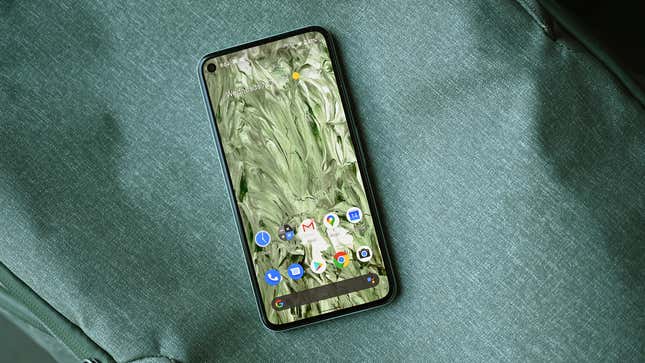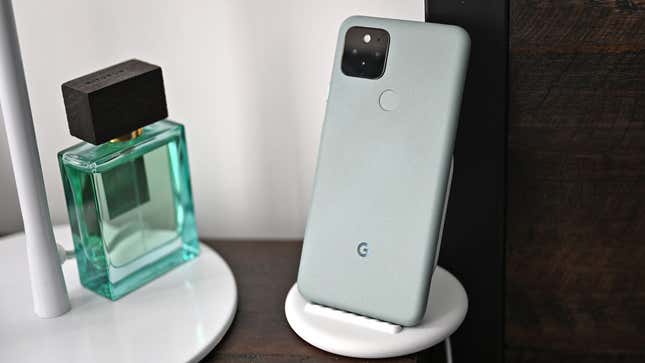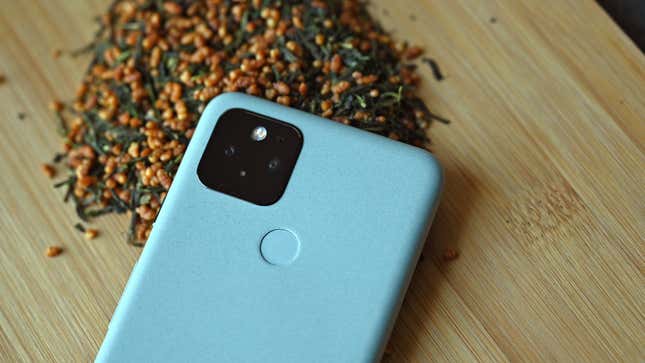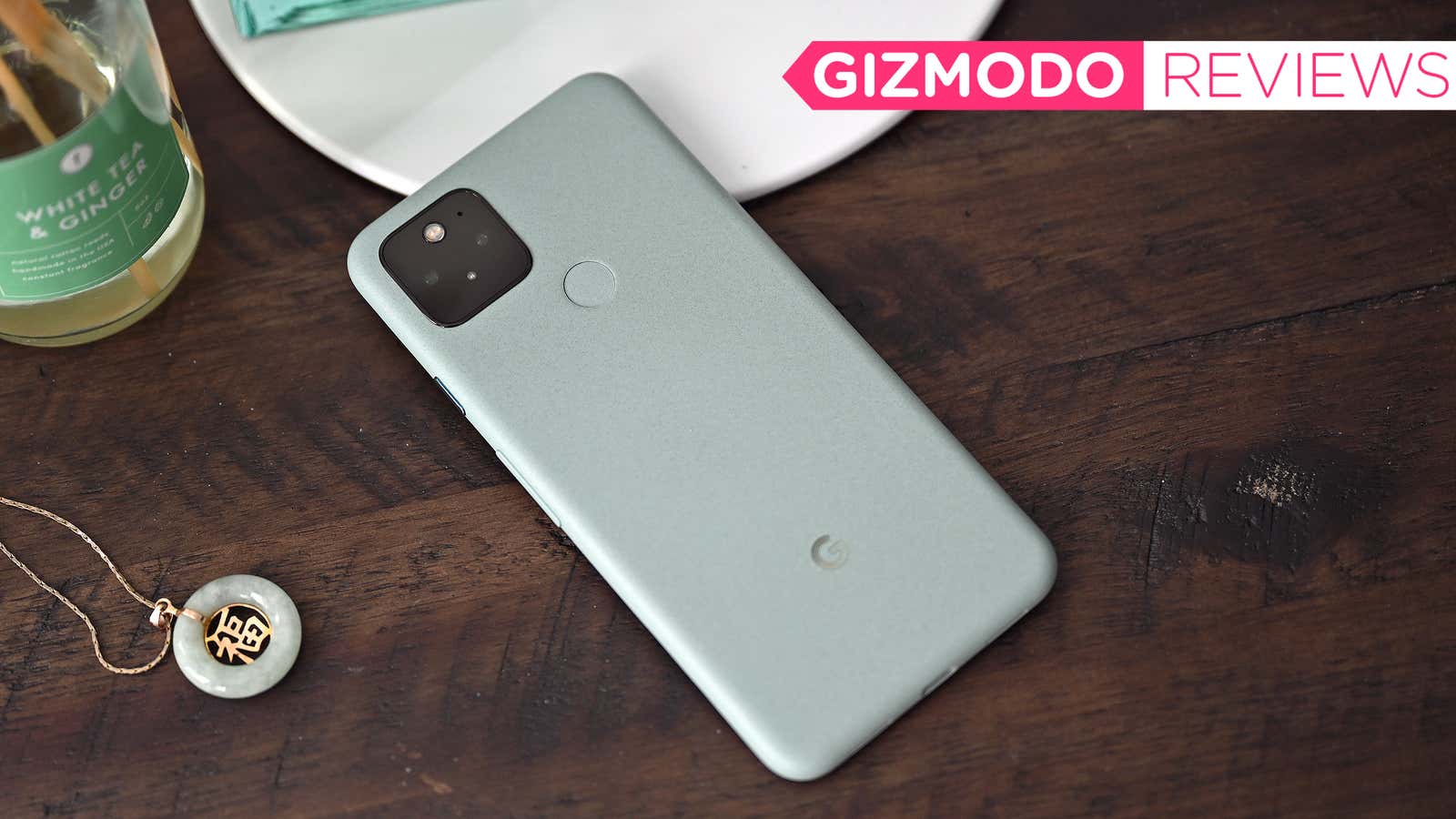Ever since Google bought a big chunk of HTC and began integrating its U.S. and Taiwan teams (the Pixel 3a was the first Pixel primarily designed in Taiwan), it’s felt like Google has been a bit confused about the Pixel’s direction. Two years ago we got a large Pixel with dual selfie cams and a fingerprint sensor in back, but then last year’s Pixel 4 featured one cam in front, two cams in back (including one with a zoom lens), and 3D facial recognition instead of a fingerprint reader.
With the Pixel 5, we get a processor that’s a tier below what most flagships are rocking, an ultra-wide camera in back instead of zoom, and no XL version to complement the standard model with its relatively small 6-inch screen. And priced at just $700, the Pixel 5 also costs hundreds less than top-end phones from Samsung, Apple, and even OnePlus. Compared to the rest of the industry, Google is zagging where everyone else is zigging, subverting expectations, and bucking a bunch of trends with almost reckless abandon. And you know what? It’s freaking working, because in a lot of ways, the Pixel 5 is the ultimate Google phone: It’s a good value and one of the most unique phones of the year.
Compared to handsets from just a couple years ago, a phone with a 6-inch screen might not sound that small, but it is. The Pixel 5 is smaller than basically every phone released this last year aside, from the iPhone SE and the upcoming iPhone 12 Mini. In fact, despite having slightly more screen real estate thanks to its slimmer bezels, the Pixel 5 is actually smaller than the Pixel 3. In a post-OG Galaxy Note world where phones have been steadily growing ever larger for the better part of a decade, it takes some serious chutzpah to downsize.
So even though I wish Google had made an XL version of the Pixel 5, the standard model’s dimensions are downright invigorating. As someone who deals with a lot of big-screen behemoths, it’s really nice to have a petite little phone that never feels heavy, bulky, or unwieldy.

On the top edge of the Pixel 5, instead of going with a slim earpiece speaker like you get on practically every other phone, Google built a speaker into the Pixel 5's display, which vibrates the screen and produces noise when you make a call. The Pixel 5's vibrating screen also works with the phone’s bottom-firing speakers to produce a sort of pseudo-stereo audio. Overall quality is a bit lacking in bass, but booming lows are something that almost no phone can meaningfully pump out. Because it doesn’t need to use a traditional earpiece speaker, the Pixel 5 has a thin, unblemished bezel (well, aside from that hole-punch selfie cam), which wraps around the entire device and results in a neat and sleek front facade.
Google has even forgone the 3D face scanner it used on the Pixel 4, along with the fancy in-display fingerprint sensors so many premium phones have adopted, in favor of a good ‘ole digit reader in back. It’s fast, it’s simple, and in a time when stuff like Face ID and face unlock are basically useless when you’re wearing a mask, it’s nice to see that old-school biometric systems still have their merits.

Strangely, perhaps the most interesting thing about the entire Pixel 5 is its back. Instead of glass or polycarbonate, the Pixel 5 technically has an aluminum body, though you’d never know it because Google has covered the Pixel 5's rear in “bio-resin.” It not only feels different than any other phone (and makes slapping a case on the phone somewhat unnecessary), it also makes the phone less slippery and allowed Google give the Pixel 5's signature Sorta Sage color more depth and richness than normal.
But the back of the Pixel 5 is weird for two reasons. First, because of the bio-resin, which feels more like leather or paper than your average plastic. But the other reason is that most phone makers avoid using aluminum backs because metal panels generally don’t play nice with wireless charging, though that didn’t stop Google. So to make wireless charging work, Google made precise cuts in the Pixel 5's aluminum back to accommodate wireless charging coils, resulting in something that’s more durable than both traditional plastic and glass, with virtually none of the drawbacks. The Pixel 5 even supports reverse wireless charging (Google calls it Battery Share), so you can power up other devices that support Qi on the fly. How that’s for ingenuity?
Furthermore, with the Pixel 5's extremely long battery life, using Battery Share is something that’s a joy to use. That’s because, despite its size, the Pixel 5's 4,000 mAh battery is actually the biggest battery Google has ever put in a Pixel. In our video rundown test, the Pixel 5 lasted 16 hours and 48 minutes. That’s the third longest time I’ve seen on a phone this year, behind the Moto Edge+ (17:18), and the Asus ROG Phone 3 (16:56). This is quite impressive because, historically, longevity has never been one of the Pixel line’s biggest strengths. But it definitely is now on the Pixel 5.
Google’s counter-logical design thinking doesn’t stop when it comes to the phone’s exterior, either. Instead of using a Snapdragon 865 chip like a lot of other premium Android phones, the Pixel 5 features a chip from Qualcomm’s next rung down: the Snapdragon 765G. It’s a savvy move, because the Snapdragon 765G still offers support for all the major flavors of 5G and ample performance, while also lowering the Pixel 5's cost.
With the Pixel 5's screen featuring a decent but not super high 2160 x 1080 resolution, much of the extra performance of a Snapdragon 865 probably would have been wasted. The Pixel 5 is more than snappy as is. Also, by cutting costs with its chip, it became easier for Google to incorporate other premium features like a rich OLED display, which also features a 90Hz refresh rate to help make games, websites, and animations look extra smooth. It’s not quite as good as 120Hz or 144Hz like you get some some more expensive phones, but it is noticeable and a worthy inclusion. Google even doubled up the Pixel 4's 64GB of base storage to 128GB on the Pixel 5, an upgrade I’m happy to take every time.

But one of the most confounding decisions (at least for casual observers) that Google made with the Pixel 5 is to use the same Sony IMX363 sensor it used in the Pixel 4 and the Pixel 3 instead of picking out the latest and greatest camera sensor. In an industry where gadget makers are expected to push out yearly refreshes, sticking with the same camera sensor for three years in a row might seem bizarre, but once again, there’s a method to the madness. Instead of having to reinvent its image processing and camera algorithms every 12 months, Google has had a consistent platform that it’s been able to truly optimize, and the results speak for themselves.
In bright light, the Pixel 5 produces pics with deep, saturated colors and more detail than you get on pretty much any other phone, regardless of price. And in darker environments, thanks to Night Sight (which now works on Portrait Mode shots), you get the best low-light camera quality around too. I also like that Google has leaned into its expertise with software to add three new video stabilization modes (locked, active, and cinematic pan), making the Pixel 5 a better tool to record special moments, both stills and video.
That said, Google did ignore one major smartphone camera trend I really wish it hadn’t: only including two rear cams instead of three. I totally understand the reasoning behind going with an ultra-wide cam instead of a zoom cam on the Pixel 5, as it’s easier to give people more reach using software via Google’s Super Res Zoom than it is to increase a phone’s field of view. But if Google just included three rear cams—a wide angle, ultra-wide, and a telephoto—the Pixel 5 would stack up much better against its competition.
Compared to the 5x optical zoom on the Galaxy Note 20 Ultra, Super Res Zoom at 5x just can’t really hang. Now I admit that’s not a very fair comparison because the Note 20 Ultra costs almost twice the Pixel 5's price, but I’d still really love to see Google supplement Super Res Zoom with even just a 2x or 3x optical zoom to help capture sharper telephoto pics.
Also, while Google’s strategy of sticking with the same image sensor for three years has worked up until now, I’m not sure how much longer that strategy can continue. Yes, the Pixel 5 manages to edge out the iPhone 11 and the latest Galaxy Note in most situations (especially low light), but that gap is closer than ever, and in bright light, Google definitely isn’t dunking on Apple and Samsung across the board. Other features like Portrait Mode with Night Sight don’t look as good as they should, and I can’t help but wonder if the Pixel 5's sensor is holding the phone back a bit in those situations. And let’s not forget, the iPhone 12 Pro Max with its advanced photography features is due out next month, which could shift that balance even more.

However, not including a zoom cam is mostly a minor offense on a phone that only costs $700, and considering how many unwritten rules Google is straight up thrashing this time around, the Pixel 5 is kind of magnificent. It’s got great camera quality, more than sufficient performance, and a sneakily innovative design—not to mention all of the Pixel exclusive software features like Duplex, Call Screener, automatic captions, and, my personal favorite, the Pixel Recorder app. So while not offering a Pixel 5 model with a bigger screen means this phone might not be a great fit for everyone, for people who prefer a more compact device, the Pixel 5 is legitimately the best small Android phone around and a pretty good overall value. This year, Google said: Screw the playbook. The Pixel 5 is better for it.
README
- Because there’s no Pixel 5 XL, if you want a new Pixel with a bigger screen, you’ll have to go with the Pixel 4a 5G.
- I really wish Google would just put three cams on the back of its top-end Pixel.
- The Pixel 5 doesn’t use a traditional earpiece speaker. Instead, it vibrates its screen (which is also used for regular audio, too, alongside the bottom speaker).
- New camera modes include Night Sight in Portrait Mode and three different stabilization settings for video (locked, active, and cinematic pan).
- The Pixel 5 has ridiculously good battery life, and it’s the best small Android phone on the market.
